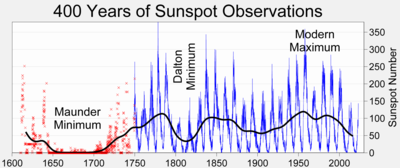An announcement by the American Astronomical Society probably not only puts a final nail in the coffin of AGW, but sets up a lot of people for a big U-turn.
It has long been a claim of Anthropogenic Global Warming (AGW) advocates that the sun has no significant effect on the temperature of the earth, that the Sun’s output is constant never changes. This assumption is one of the fundamental constants in climate models in current use.
Reality tells a different story. The Sun is a horribly complex system, not really well understood by scientists. it is much more than just a big ball of (fusion) fire in the sky. It undergoes many dynamic events on regular cycles. The one that most people are at least peripherally aware of is the sunspot cycle, which is an approximately 11 year cycle where the number of sunspots varies, and along with that particle emissions which cause Aurora and radio propagation changes on Earth.
 There have been variation in this cycle that have been documented now for around 400 years. During that time there have been observed variation in the intensity of sunspots. There are two well documented minimums, where there were no, or very few sunspots, even at what should have been the height of the 11 year sunspot cycle.
There have been variation in this cycle that have been documented now for around 400 years. During that time there have been observed variation in the intensity of sunspots. There are two well documented minimums, where there were no, or very few sunspots, even at what should have been the height of the 11 year sunspot cycle.

The biggest of these was known as the Maunder Minimum, which lasted from roughly 1645 to 1715, and another known as the Dalton Minimum, running from1790 to 1830.
These minimums have coincided with some very cold periods (which AGW proponents have tried very hard to pretend never happened) – a period known as the Little Ice Age corresponding to the Maunder Minimum.
Paintings from the period document cold not seen in modern times, such as this painting by Pieter Brugel in 1565:
and this painting of the frozen river Thames in 1677:
The Dalton Minimum was not as deep and lasted a much shorter time. However, there were cooling effects such as a measured 2.0°C decline over 20 years measured at a weather station in Oberlach, Germany, and also the “Year Without a Summer” (1816) during which 1,800 people are reported to have frozen to death in New England.
Back beyond the earliest records of sunspot observations, there are indications, based upon analysis of C14 in tree rings, of another minimum, known as the Spörer Minimum, which lasted for approximately 90 years and coincided with abnormally low temperatures.
So what, you may ask, does this have to do with the AAS and today?
The AAS announcement included this:
Some unusual solar readings, including fading sunspots and weakening magnetic activity near the poles, could be indications that our sun is preparing to be less active in the coming years.
The results of three separate studies seem to show that even as the current sunspot cycle swells toward the solar maximum, the sun could be heading into a more-dormant period, with activity during the next 11-year sunspot cycle greatly reduced or even eliminated.
 The evidence for this is fairly clear. The predictions for the maximum number of sunspots for the current cycle (24) has been reduced again and again. There are also measurements of magnetic effects of the quietening sun such as this graph showing the weakening magnetic field of the Sun.
The evidence for this is fairly clear. The predictions for the maximum number of sunspots for the current cycle (24) has been reduced again and again. There are also measurements of magnetic effects of the quietening sun such as this graph showing the weakening magnetic field of the Sun.
Another interesting observation is the following pair of graphs. They basically show the weakening of the observed sunspots.
 The brightness of the sunspots is increasing, and the magnetic field they produce is weakening. When the intensity reaches 1, and the magnetic field reaches 1500, sunspots will no longer be observable.
The brightness of the sunspots is increasing, and the magnetic field they produce is weakening. When the intensity reaches 1, and the magnetic field reaches 1500, sunspots will no longer be observable.
Based upon the past experiences, it is reasonable to assume that if/when the sun does go quiet, we can expect to see some significant falls in temperature.
It may take a while to sink in, but rather than concentrating policy on making energy too expensive to heat homes even now, and developing crops to produce ethanol, energy should be going into build energy resources that will actually work and produce far more energy that currently available, and crop development should be concentrating on crops which can successfully be grown in lower temperatures ans growing season which may be as much as 60 days shorter.
Failure to do so, and continuing to build solar farms that stop working when covered by snow and windmills that will freeze (and wouldn’t produce enough energy even if they did turn) will doom many millions of people to starvation and death by freezing.
———
As an afterthought, here are the NASA predictions for the current sunspot cycle, starting in 2007 through to today.
Note how not only does the amplitude drop, but things get pushed further and further out into the future:






